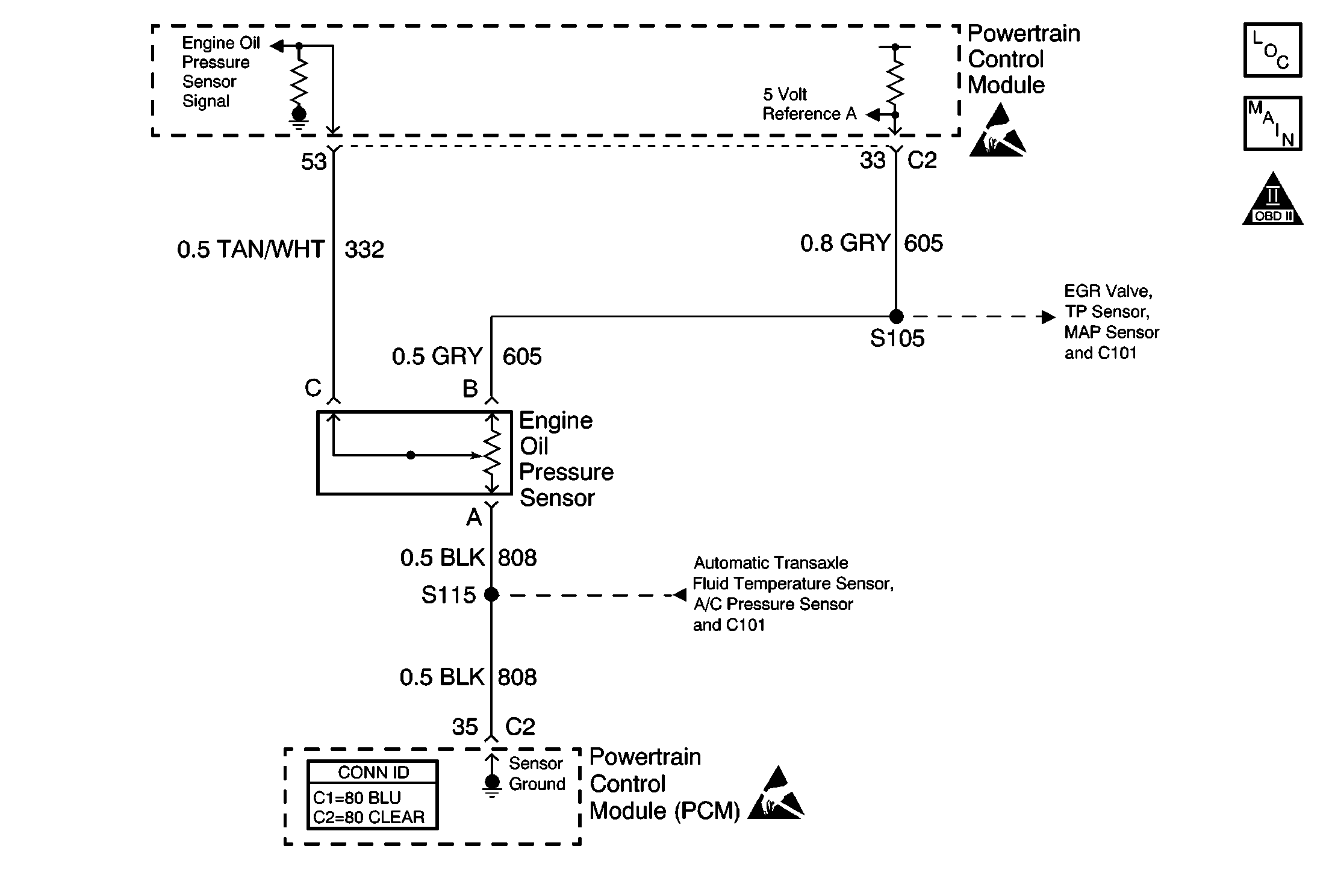
Circuit Description
The engine oil pressure sensor is a solid state transducer. The engine oil pressure sensor sends oil pressure information to the PCM. The PCM then transmits the oil pressure information to the IPC via serial data circuit.
Engine oil pressure is displayed on the scan tool in volts. A low voltage reading indicates low oil pressure. As the oil pressure increases, the voltage level also increases. The normal range of the engine oil level sensor signal voltage is 0.5 volts at 0 kPa (0 psi)-4.5 volts at 883 kPa (128 psi).
Conditions for Running
| • | Engine is running. |
| • | No 5V Ref A codes set. |
Conditions for Setting
| • | Engine oil pressure sensor voltage is equal to or more than 4.6 volts. |
| • | The above condition exists for 9 seconds. |
Action Taken When the DTC Sets
The PCM stores conditions which were present when the DTC set as Failure Records only. This information will not be stored as Freeze Frame Records.
Conditions for Clearing the MIL/DTC
| • | The DTC becomes history when the conditions for setting the DTC are no longer present. |
| • | The history DTC clears after 40 malfunction free warm-up cycles. |
| • | The PCM receives a clear code command from the scan tool. |
Diagnostic Aids
For diagnosis of the instrument panel, refer to Diagnostic Starting Point .
Check for the following conditions:
| • | Poor connection at the PCM or the engine oil pressure sensor. |
| Inspect harness connectors for the following conditions: |
| - | Backed out terminals. |
| - | Improper mating. |
| - | Broken locks. |
| - | Improperly formed or damaged terminals. |
| - | Poor terminal to wire connection. |
| • | Damaged harness. |
| Inspect the wiring harness for damage. |
| • | Instrument panel cluster. |
| The engine oil pressure sensor diagnostic table is intended to isolate electrical faults that affect the engine oil pressure sensor, the PCM, and related circuits. If a problem with engine oil pressure can not be isolated using the engine oil pressure sensor diagnostic table, refer to Diagnostic Starting Point . |
Test Description
The numbers below refer to the step numbers on the diagnostic table.
Step | Action | Values | Yes | No |
|---|---|---|---|---|
1 | Did you perform the Powertrain On-Board Diagnostic (OBD) System Check? | -- | Go to Step 2 | |
2 |
Important: If DTC P1635 5 Volt Reference Circuit is set, perform that diagnostic first.
Does the scan tool indicate that the EOP voltage parameter is above the specified value? | .4 V | Go to Diagnostic Aids | Go to Step 3 |
3 |
Does the scan tool indicate that the EOP voltage parameter is equal to the specified value? | 5 V | Go to Step 7 | Go to Step 4 |
4 |
Does the voltage measure less than the specified value? | 5 V | Go to Step 5 | Go to Step 6 |
5 | Test the 5 volt reference circuit of the EOP sensor for a short to ground, a high resistance, or an open. Refer to Circuit Testing and Wiring Repairs in Wiring Systems. Did you find and correct the condition? | -- | Go to Step 11 | Go to Step 8 |
6 | Test the signal circuit of the EOP sensor for a short to ground, a high resistance, or an open. Refer to Circuit Testing and Wiring Repairs in Wiring Systems. Did you find and correct the condition? | -- | Go to Step 11 | Go to Step 8 |
7 | Inspect for poor connections at the harness connector of the EOP sensor. Refer to Testing for Intermittent Conditions and Poor Connections and Connector Repairs in Wiring Systems. Did you find and correct the condition? | -- | Go to Step 11 | Go to Step 9 |
8 | Inspect for poor connections at the harness connector of the PCM. Refer to Testing for Intermittent Conditions and Poor Connections and Connector Repairs in Wiring Systems. Did you find and correct the condition? | -- | Go to Step 11 | Go to Step 10 |
9 | Replace the EOP sensor. Did you complete the replacement? | -- | Go to Step 11 | -- |
|
Important: Perform the set up procedure for the PCM . Replace the PCM. Refer to Powertrain Control Module Replacement/Programming . Did you complete the replacement? | -- | Go to Step 11 | -- | |
11 |
Does the DTC reset? | -- | Go to Step 2 | System OK |
